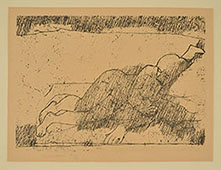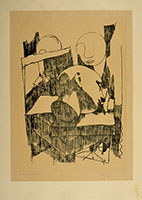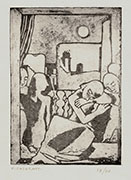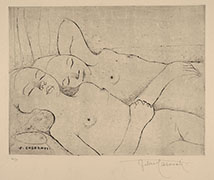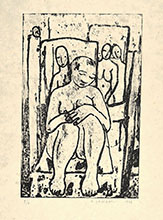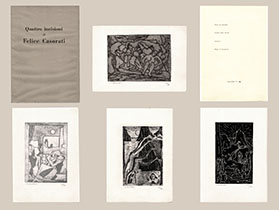(Novara 1883 - Turin 1963)
FANCIULLE DORMIENTI (TWO SLEEPING GIRLS), 1927
Etching and drypoint, signed in the plate F. CASORATI, numbered and signed in pencil at the lower margin 38/75 / Felice Casorati; a fine impression on simili Japon. Full margins, evenly toned, otherwise in very good condition. To the platemark 245 x 326 mm, the entire sheet measuring 498 x 635 mm.
PROVENANCE: the print was published by Lamberto Vitali for his Grafica Moderna editions and bears his blind mark: a cricket with letters G M.
Casorati spent his formative years in Padua where he developed a passion for music and literature. He began to paint in 1902 but to please his mother he read law at the University of Padua, graduating in 1906. He continued to paint meanwhile and in 1907 he exhibited at the Venice Biennale. Casorati's early works were marked by the influence of the Viennese Secession, Art Nouveau and Symbolism. When his father died in 1917 he moved with his family to Turin, where he soon became a central figure in the intellectual circles of the town. In his more mature works, after the war, decorative detail was substituted by the meditation of an essential form, influenced by the mathematical spatial structures of 15th century painting. Although he took part at the Novecento exhibition in 1926 and in 1929, Casorati remained independent from the movement. In 1923 he opened a school for young artists in his studio in Via Mazzini, Turin. In 1925 he was among the founders of the Antonio Fontanesi Fine Arts Society, to promote exhibitions of contemporary nineteenth century Italian and foreign artists. In 1935 the studio of Casorati and Enrico Paulucci held the first collective exhibition of Italian abstract art, which included works of Licini, Melotti and Fontana. Casorati won the painting award at the Venice Biennial in 1938. He also received official recognition at the important exhibitions in Paris, Pittsburgh and San Francisco. In 1952 he held a personal exhibition at the Venice Biennial, and with Ottone Rosai he received the special presidency award.

